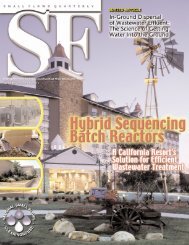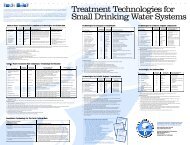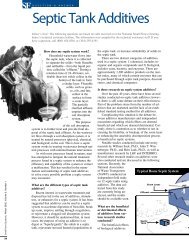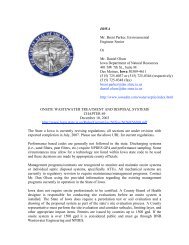Craig Mains | Technical Assistant - National Environmental Services ...
Craig Mains | Technical Assistant - National Environmental Services ...
Craig Mains | Technical Assistant - National Environmental Services ...
You also want an ePaper? Increase the reach of your titles
YUMPU automatically turns print PDFs into web optimized ePapers that Google loves.
Every once in awhile an idea comes around that is so<br />
environmentally sound that people wonder why it hasn’t<br />
already become standard practice. It just takes the right<br />
biological combination to present the perfect environmental<br />
equation.<br />
That may be case with alga (or its plural algae) and<br />
wastewater. The combination of these two substances<br />
through science and biological breakdown produce one<br />
of the world’s most valuable resources: biofuel. And not<br />
only can the combination of algae and wastewater produce<br />
biofuel, but the algae actually treat the wastewater<br />
in the process.<br />
It’s every environmentalist’s dream. Take human<br />
waste, add a naturally occurring, abundant, aquatic organism<br />
and end up with a valuable, renewable energy<br />
source. To some, algae is just green slime, but combining<br />
that green slime with nutrient-rich wastewater may just<br />
end up producing black gold for many wastewater utilities.<br />
In fact, many environmental experts believe that the<br />
combination of algae and wastewater may be the key to<br />
a low-carbon future—an oil utopia of sorts.<br />
Gerald Iwan, executive director of the <strong>National</strong> <strong>Environmental</strong><br />
<strong>Services</strong> Center, says, “This concept is possibly<br />
the new frontier. The concept is really the ultimate in<br />
being green, innovative, and thinking outside of the box.<br />
“[Algae] is a complex organism once considered a<br />
nuisance to many wastewater and drinking water utilities.<br />
It has been a problem for treatment plants for a long,<br />
long time. Now it is under the microscope, pardon the<br />
pun, for other uses. They used to harvest it and throw it<br />
in a landfill; it was a big problem—now that problem<br />
could turn into a positive.”<br />
Why Algae?<br />
Interest in producing fuel from algae first surfaced in<br />
the 1950s. Scientists began using an algal byproduct as<br />
fuel in 1978 after the gas crisis of the 1970s prompted<br />
the government to investigate alternative fuels to lessen<br />
America’s dependency on Middle Eastern oil. The Aquatic<br />
Species Program, run by the <strong>National</strong> Renewable Energy<br />
Laboratory, researched algae for biofuel and found<br />
that algae could replace fossil fuels for heating and transportation<br />
purposes. Gradually, interest in algal biofuel<br />
was put on the back burner in the 1990s as oil became<br />
cheap.<br />
But as oil prices began to rise and the country’s energy<br />
security was threatened again earlier this century, biofuel<br />
became a popular green idea. Biofuel made from<br />
corn, sugar cane, and switchgrass has been touted and<br />
experimented with for several years as a cheap alternative<br />
to fossil fuel. However, in the last several years, algal<br />
biofuel has been regaining interest.<br />
Part of the lure of algae is how seemingly simple it is<br />
to grow, as any swimming pool or fish tank owner can tell<br />
you. The inputs are easily available and consist of sunlight,<br />
water, and carbon dioxide. Another plus is that on<br />
average, algae produce large amounts of oil.<br />
The U.S. Department of Energy says that algae can<br />
potentially produce 100 times more oil per acre than soybeans<br />
or any other terrestrial oil-producing plant. It can<br />
be cultivated in open ponds and in virtually any type of<br />
climate, including deserts.<br />
Several companies are testing different strains of<br />
algae, searching for the one that has the highest oil content,<br />
absorbs carbon dioxide the fastest, grows the<br />
fastest, and leaves the smallest carbon footprint possible.<br />
Pharmaceutical and cosmetic companies have used<br />
algae for years to manufacture their products. “It’s even<br />
been used as a thickener for ice cream. Algae are fascinating<br />
stuff,” Iwan adds. “For those of us in the industry, it<br />
used to just be about water and wastewater, but now it<br />
could be about energy too.”<br />
Algal energy research has been escalating in the last<br />
few years. Oil giants are pouring money into algal research,<br />
pondering the quality of the biofuel and its ability<br />
to reduce the country’s dependence on fossil fuels.<br />
Many experts say the application of algal biofuel will<br />
be as efficient and work as well as typical fossil fuel.<br />
Supporting that theory, Continental Airlines has already<br />
completed a successful test flight using biofuel created,<br />
in part, from algae, according to an August 2009, CNN<br />
report.<br />
And Josh Tickell, an author, filmmaker, and alternative-fuel<br />
advocate, who first drove across the country 11<br />
years ago in an alternative-fuel vehicle running on vegetable<br />
oil, just completed a transcontinental journey in a<br />
Toyota Prius fueled partially on algal biofuel.<br />
Exxon announced in July that it had invested $600<br />
million in producing liquid transportation fuels from algae,<br />
according to a July 14, 2009, New York Times article. The<br />
article states that approximately 9 percent of the nation’s<br />
liquid fuel supply comes from biofuels, most of it cornbased<br />
ethanol. However, Congress has mandated that by<br />
2022 biofuel levels reach 36 billion gallons.<br />
According to Exxon, algae could produce more than<br />
2,000 gallons of fuel per acre of production each year<br />
compared to corn that typically yields only 250 gallons<br />
per acre a year.<br />
Of course, the massive amount of nutrients readily<br />
available in wastewater could aid in that algal growth.<br />
That’s where wastewater treatment plants come in.<br />
Background and Research<br />
Wastewater professionals have used algae to treat<br />
wastewater since the late 1960s or early 1970s when<br />
William J. Oswald, a University of California– Berkeley<br />
professor, was among the first pioneers of the idea. In<br />
scientific circles, Oswald is credited with using algae and<br />
bacteria in treatment pond systems to develop natural<br />
methods for wastewater treatment.<br />
Small Flows Magazine, Fall/Winter 2009, Volume 9, Number 3 2<br />
13

















